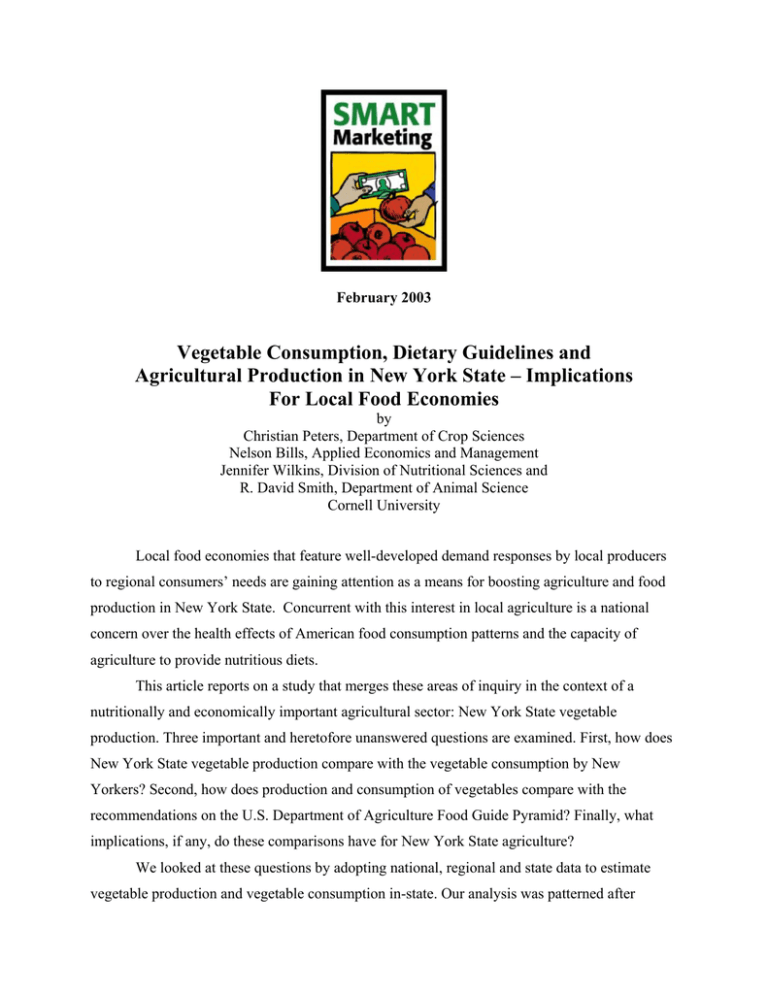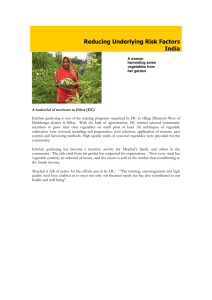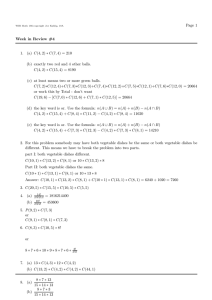Vegetable Consumption, Dietary Guidelines and
advertisement

February 2003 Vegetable Consumption, Dietary Guidelines and Agricultural Production in New York State – Implications For Local Food Economies by Christian Peters, Department of Crop Sciences Nelson Bills, Applied Economics and Management Jennifer Wilkins, Division of Nutritional Sciences and R. David Smith, Department of Animal Science Cornell University Local food economies that feature well-developed demand responses by local producers to regional consumers’ needs are gaining attention as a means for boosting agriculture and food production in New York State. Concurrent with this interest in local agriculture is a national concern over the health effects of American food consumption patterns and the capacity of agriculture to provide nutritious diets. This article reports on a study that merges these areas of inquiry in the context of a nutritionally and economically important agricultural sector: New York State vegetable production. Three important and heretofore unanswered questions are examined. First, how does New York State vegetable production compare with the vegetable consumption by New Yorkers? Second, how does production and consumption of vegetables compare with the recommendations on the U.S. Department of Agriculture Food Guide Pyramid? Finally, what implications, if any, do these comparisons have for New York State agriculture? We looked at these questions by adopting national, regional and state data to estimate vegetable production and vegetable consumption in-state. Our analysis was patterned after methods established by the Economic Research Service to make national comparisons of farm commodity production and food consumption to see how they stack up against the Food Pyramid recommendations. Regarding consumption, we determined that no comprehensive data exist for New York; instead, we adopted annual per capita vegetable consumption estimates for the Northeast. We estimate that New Yorkers consume approximately 160 pounds of vegetables per person per year. This is vegetable intake—after accounting for inedible portions, food loss, and so on. Based on population estimates, this level of per capita consumption indicates that in-state vegetable consumption was about 2.9 billion pounds in calendar year 1999. In contrast, New York State farmers harvested an average of 3.3 billion pounds of vegetables annually during the 5-year period 1994-1998. After knitting together all available production data, we find that this production comes from 81 individual “vegetable crops”. Included were edible dry bean crops that usually are not categorized as vegetable commodities in production statistics. After adjusting for post-harvest losses and inedible portions, the consumable equivalent of New York’s farmgate production is 1.6 billion pounds. Based on a crop-by-crop comparison, New York produces a handful of vegetable crops (e.g., beets, cabbage, onions, pumpkins, snap beans, and sweet corn) in quantities that exceed the estimated in-state demand. As a result, New York produces enough vegetables to provide 38 percent of the total vegetable consumption plus 500 million pounds of “surplus” of the aforementioned crops. Our comparisons with the Food Guide Pyramid demonstrate that both vegetable consumption and production in New York State mirror national trends. New Yorkers eat too few nutritionally important vegetables. Consumption of the “dark green leafy & deep yellow vegetables” and the “dry legumes” are only 41 percent and 19 percent, respectively, of the recommended amounts. Though New York State harvests enough dry edible beans to match the current level of consumption, it is well below the recommended amount. Furthermore, New York is a minor producer of the dark green leafy and deep yellow vegetables, producing only 12 percent of the recommended number of servings. We believe that our study could have favorable implications for New York State vegetable growers and consumers. Our intent was to improve understanding of the links between vegetable consumption, vegetable production, and nutrition --all within the context of New York agriculture. We view such understanding as the necessary starting point for identifying any 2 potential for New York agriculture to both supply a greater share of produce to New York residents and promote better state-wide nutrition. There are limits to the implications that can be drawn from our study regarding the prospects for expanding or reducing vegetable acreage in New York State. Growers are responding to prices, anticipated trends and other market factors, as well as their new and ongoing relationships with buyers of their product. This study does not address prices or the nature of these marketing relationships. Nonetheless, our results help producers make informed future decisions regarding vegetable production by estimating the volume of in-state consumption and the directions in which state vegetable consumption may be trending as healthconscious New York State consumers adhere more closely to nutritional guidelines. Considered in this light, our results help pave the way for estimates of the potential market value of vegetables currently consumed in smaller amounts locally (statewide) as well as revealing the potential influence of expanding ethnic markets and other trends in consumer preferences and food choices. Such information can be increasingly important to growers who can gain strategic advantages in targeting local, ethnic, or other demographically important markets. One marketing approach that could be supported by this research is expanding production of crops currently being under-produced relative to consumption, exploiting local niche markets further. Producers now targeting a few high volume markets for processed or fresh vegetables would do well to consider the results of this study in light of their prospects for diversifying production and possibly increasing the economic vibrancy of their businesses. Looking across New York State, the vegetable sector is arguably one of the biggest success stories of New York State agriculture. Today as in years past, sales of vegetables to fresh and processed markets constitute one of the largest sources of income for New York farmers. In addition, though New York State has lost millions of farmland acres to either development or reforestation since the 1950s, land used for vegetable production has remained fairly constant at 170,000 acres. Moreover, though the total number of farms in New York has declined precipitously in the last 50 years, the number of farms classified as vegetable farms by the Census has remained amazingly stable. Indeed, despite many dramatic changes in the industry over the last century, vegetable production continues to be a mainstay of New York agriculture. 3 Identifying potential production opportunities for producers is beyond the reach of this study, primarily because those opportunities are greatly intertwined with decisions producers must make about their own market options. Nonetheless, our study adds new perspective and context to these farm-level marketing discussions, and illuminates areas where additional research is needed in setting goals and researching in-state markets for vegetable commodities. From the work we present, large-, medium-, and small-volume vegetable producers will undoubtedly discover new options for targeting New York State consumers and capitalizing on demographic and ethnic market trends, as more nutrition-savvy New Yorkers adhere to the Food Guide Pyramid dietary standards. For the complete report please see: http://aem.cornell.edu/research/researchpdf/rb0207.pdf "Smart Marketing" is a monthly marketing newsletter for extension publication in local newsletters and for placement in local media. It reviews the elements critical to successful marketing in the food and agricultural industry. Articles are written by faculty members in the Department of Applied Economics and Management at Cornell University. "Share the gift of communication." Please cite or acknowledge when using this material. 4




